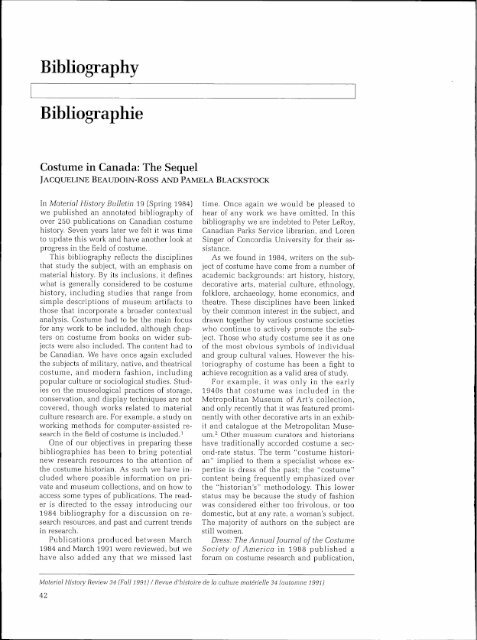Revue d'histoire de la culture materielle - Memorial University's ...
Revue d'histoire de la culture materielle - Memorial University's ...
Revue d'histoire de la culture materielle - Memorial University's ...
Create successful ePaper yourself
Turn your PDF publications into a flip-book with our unique Google optimized e-Paper software.
Bibliography<br />
Bibliographie<br />
Costume in Canada : The Sequel<br />
JACQUELINE BEAUDOIN-ROSS AND PAMELA BLACKSTOCK<br />
In Material History Bulletin 19 (Spring 1984)<br />
we published an annotated bibliography of<br />
over 250 publications on Canadian costume<br />
history. Seven years <strong>la</strong>ter we felt it was time<br />
to update this work and have another look at<br />
progress in the field of costume .<br />
This bibliography reflects the disciplines<br />
that study the subject, with an emphasis on<br />
material history . By its inclusions, it <strong>de</strong>fines<br />
what is generally consi<strong>de</strong>red to be costume<br />
history, including studies that range from<br />
simple <strong>de</strong>scriptions of museum artifacts to<br />
those that incorporate a broa<strong>de</strong>r contextual<br />
analysis . Costume had to be the main focus<br />
for any work to be inclu<strong>de</strong>d, although chapters<br />
on costume from books on wi<strong>de</strong>r subjects<br />
were also inclu<strong>de</strong>d . The content had to<br />
be Canadian . We have once again exclu<strong>de</strong>d<br />
the subjects of military, native, and theatrical<br />
costume, and mo<strong>de</strong>rn fashion, including<br />
popu<strong>la</strong>r <strong>culture</strong> or sociological studies . Studies<br />
on the museological practices of storage,<br />
conservation, and disp<strong>la</strong>y techniques are not<br />
covered, though works re<strong>la</strong>ted to material<br />
<strong>culture</strong> research are . For example, a study on<br />
working methods for computer-assisted research<br />
in the field of costume is inclu<strong>de</strong>d .'<br />
One of our objectives in preparing these<br />
bibliographies has been to bring potential<br />
new research resources to the attention of<br />
the costume historian . As such we have inclu<strong>de</strong>d<br />
where possible information on private<br />
and museum collections, and on how to<br />
access some types of publications . The rea<strong>de</strong>r<br />
is directed to the essay introducing our<br />
1984 bibliography for a discussion on research<br />
resources, and past and current trends<br />
in research .<br />
Publications produced between March<br />
1984 and March 1991 were reviewed, but we<br />
have also ad<strong>de</strong>d any that we missed <strong>la</strong>st<br />
time . Once again we would be pleased to<br />
hear of any work we have omitted . In this<br />
bibliography we are in<strong>de</strong>bted to Peter LeRoy,<br />
Canadian Parks Service librarian, and Loren<br />
Singer of Concordia University for their assistance<br />
.<br />
As we found in 1984, writers on the subject<br />
of costume have come from a number of<br />
aca<strong>de</strong>mic backgrounds : art history, history,<br />
<strong>de</strong>corative arts, material <strong>culture</strong>, ethnology,<br />
folklore, archaeology, home economics, and<br />
theatre . These disciplines have been linked<br />
by their common interest in the subject, and<br />
drawn together by various costume societies<br />
who continue to actively promote the subject<br />
. Those who study costume see it as one<br />
of the most obvious symbols of individual<br />
and group cultural values . However the historiography<br />
of costume has been a fight to<br />
achieve recognition as a valid area of study.<br />
For example, it was only in the early<br />
1940s that costume was inclu<strong>de</strong>d in the<br />
Metropolitan Museum of Art's collection,<br />
and only recently that it was featured prominently<br />
with other <strong>de</strong>corative arts in an exhibit<br />
and catalogue at the Metropolitan Museum<br />
.2 Other museum curators and historians<br />
have traditionally accor<strong>de</strong>d costume a second-rate<br />
status . The term "costume historian"<br />
implied to them a specialist whose expertise<br />
is dress of the past ; the "costume"<br />
content being frequently emphasized over<br />
the "historian's" methodology. This lower<br />
status may be because the study of fashion<br />
was consi<strong>de</strong>red either too frivolous, or too<br />
domestic, but at any rate, a woman's subject .<br />
The majority of authors on the subject are<br />
still women .<br />
Dress : The Annual Journal of the Costume<br />
Society of America in 1988 published a<br />
forum on costume research and publication,<br />
Material History Review 34 (Fall 1991) / <strong>Revue</strong> <strong>d'histoire</strong> <strong>de</strong> <strong>la</strong> <strong>culture</strong> <strong>materielle</strong> 34 (automne 1991)<br />
42

















